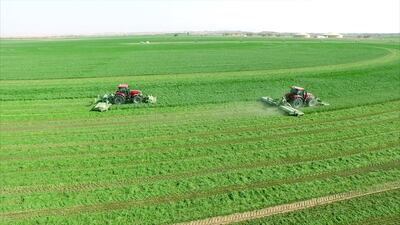There has been a rare UAE sighting of Radde's accentor – a small bird that favours alpine habits.
The brown bird with black patches over its eyes and crown, which are separated by white eyebrow stripes, had previously been recorded only once in the Emirates, back in 2012.
It can be found from Turkey through to parts of Syria and Iran and as far east as Turkmenistan, but does not normally visit the UAE.
Radde's accentor – scientific name Prunella ocularis – breeds in rocky areas, near the treeline, in bushes and scrub.
A few seconds later someone said it is one of the rarest. You have hit the jackpot
Reza Khan
Reza Khan, the former manager of Dubai Zoo, who is now principal wildlife specialist at Dubai Safari Park and Dubai Municipality, saw the bird in Wadi Shees Park in Khor Fakkan, Sharjah, this week. The park is a noted haven for flora and fauna.
He took a picture and shared it with his birdwatching friends on WhatsApp groups.
“A few seconds later someone said it is one of the rarest. You have hit the jackpot,” said Mr Khan, who was carrying out an official bird survey when he saw the Radde's accentor.
“I couldn’t identify it at the time as I didn’t have a book with me. It is very rare to find it here.”
It was still there on Friday, added Mr Khan.
The species typically migrates from high altitudes to low altitudes in winter.
Mr Khan said the bird is classed as a vagrant by ornithologists. This means it was found outside of its normal range.
It could be that the bird was blown off course by a storm, has a faulty internal GPS, which steered it the wrong way or may have got confused due to the effects of climate change.
In the aftermath of Cyclone Shaheen, several species of birds which are not usually found in Oman visited the country, with white cranes, ospreys, flamingos and species of geese seen wading in the flood waters.
Radde's accentor is not the first vagrant species recorded in the UAE, Mr Khan said.
“A few years back, in 2018, I found an American bird,” he said.
Rare sighting of sociable lapwing in Abu Dhabi
And at the start of the month, a birdwatcher spotted a white-breasted kingfisher in Sila, on the UAE border with Saudi Arabia.
It was the sixth time the species had been recorded in the UAE. They are normally found from south China to Egypt.
Mr Khan said he went there to see if he could spot the kingfisher a couple of days later. He did not, but saw a brambling instead. It was only the third time the bird, a finch common in Europe and Asia, has been seen in the UAE.
Mr Khan said Sila is a particularly good birdwatching site because it is the first land birds reach after flying over the Arabian Gulf.
“We have recorded many birds there,” he said.
“Because when they cross that is the first place the birds see. They may be there for a few hours or for the day.”
The sighting of record numbers of another critically endangered bird in Abu Dhabi this year excited conservationists.
At least 34 sociable lapwings – scientific name Vanellus gregarius – were recorded at Al Maha Pivot Fields on February 16. This is almost three times the previous record, when 12 were sighted.
Numbers have declined more than 90 per cent since the 1930s, with just 24,000 left in the world.
The Bio
Amal likes watching Japanese animation movies and Manga - her favourite is The Ancient Magus Bride
She is the eldest of 11 children, and has four brothers and six sisters.
Her dream is to meet with all of her friends online from around the world who supported her work throughout the years
Her favourite meal is pizza and stuffed vine leaves
She ams to improve her English and learn Japanese, which many animated programmes originate in
WHY%20AAYAN%20IS%20'PERFECT%20EXAMPLE'
%3Cp%3EDavid%20White%20might%20be%20new%20to%20the%20country%2C%20but%20he%20has%20clearly%20already%20built%20up%20an%20affinity%20with%20the%20place.%3Cbr%3E%3Cbr%3EAfter%20the%20UAE%20shocked%20Pakistan%20in%20the%20semi-final%20of%20the%20Under%2019%20Asia%20Cup%20last%20month%2C%20White%20was%20hugged%20on%20the%20field%20by%20Aayan%20Khan%2C%20the%20team%E2%80%99s%20captain.%3Cbr%3E%3Cbr%3EWhite%20suggests%20that%20was%20more%20a%20sign%20of%20Aayan%E2%80%99s%20amiability%20than%20anything%20else.%20But%20he%20believes%20the%20young%20all-rounder%2C%20who%20was%20part%20of%20the%20winning%20Gulf%20Giants%20team%20last%20year%2C%20is%20just%20the%20sort%20of%20player%20the%20country%20should%20be%20seeking%20to%20produce%20via%20the%20ILT20.%3Cbr%3E%3Cbr%3E%E2%80%9CHe%20is%20a%20delightful%20young%20man%2C%E2%80%9D%20White%20said.%20%E2%80%9CHe%20played%20in%20the%20competition%20last%20year%20at%2017%2C%20and%20look%20at%20his%20development%20from%20there%20till%20now%2C%20and%20where%20he%20is%20representing%20the%20UAE.%3Cbr%3E%3Cbr%3E%E2%80%9CHe%20was%20influential%20in%20the%20U19%20team%20which%20beat%20Pakistan.%20He%20is%20the%20perfect%20example%20of%20what%20we%20are%20all%20trying%20to%20achieve%20here.%3Cbr%3E%3Cbr%3E%E2%80%9CIt%20is%20about%20the%20development%20of%20players%20who%20are%20going%20to%20represent%20the%20UAE%20and%20go%20on%20to%20help%20make%20UAE%20a%20force%20in%20world%20cricket.%E2%80%9D%C2%A0%3C%2Fp%3E%0A
If you go...
Flying
There is no simple way to get to Punta Arenas from the UAE, with flights from Dubai and Abu Dhabi requiring at least two connections to reach this part of Patagonia. Flights start from about Dh6,250.
Touring
Chile Nativo offers the amended Los Dientes trek with expert guides and porters who are met in Puerto Williams on Isla Navarino. The trip starts and ends in Punta Arenas and lasts for six days in total. Prices start from Dh8,795.
UAE currency: the story behind the money in your pockets
Tips for job-seekers
- Do not submit your application through the Easy Apply button on LinkedIn. Employers receive between 600 and 800 replies for each job advert on the platform. If you are the right fit for a job, connect to a relevant person in the company on LinkedIn and send them a direct message.
- Make sure you are an exact fit for the job advertised. If you are an HR manager with five years’ experience in retail and the job requires a similar candidate with five years’ experience in consumer, you should apply. But if you have no experience in HR, do not apply for the job.
David Mackenzie, founder of recruitment agency Mackenzie Jones Middle East
Red Sparrow
Dir: Francis Lawrence
Starring: Jennifer Lawrence, Joel Egerton, Charlotte Rampling, Jeremy Irons
Three stars
Bib%20Gourmand%20restaurants
%3Cp%3EAl%20Khayma%0D%3Cbr%3EBait%20Maryam%0D%3Cbr%3EBrasserie%20Boulud%0D%3Cbr%3EFi'lia%0D%3Cbr%3Efolly%0D%3Cbr%3EGoldfish%0D%3Cbr%3EIbn%20AlBahr%0D%3Cbr%3EIndya%20by%20Vineet%0D%3Cbr%3EKinoya%0D%3Cbr%3ENinive%0D%3Cbr%3EOrfali%20Bros%0D%3Cbr%3EReif%20Japanese%20Kushiyaki%0D%3Cbr%3EShabestan%0D%3Cbr%3ETeible%3C%2Fp%3E%0A
Schedule:
Sept 15: Bangladesh v Sri Lanka (Dubai)
Sept 16: Pakistan v Qualifier (Dubai)
Sept 17: Sri Lanka v Afghanistan (Abu Dhabi)
Sept 18: India v Qualifier (Dubai)
Sept 19: India v Pakistan (Dubai)
Sept 20: Bangladesh v Afghanistan (Abu Dhabi) Super Four
Sept 21: Group A Winner v Group B Runner-up (Dubai)
Sept 21: Group B Winner v Group A Runner-up (Abu Dhabi)
Sept 23: Group A Winner v Group A Runner-up (Dubai)
Sept 23: Group B Winner v Group B Runner-up (Abu Dhabi)
Sept 25: Group A Winner v Group B Winner (Dubai)
Sept 26: Group A Runner-up v Group B Runner-up (Abu Dhabi)
Sept 28: Final (Dubai)
Our family matters legal consultant
Name: Hassan Mohsen Elhais
Position: legal consultant with Al Rowaad Advocates and Legal Consultants.
if you go
The flights
Etihad and Emirates fly direct from the UAE to Seoul from Dh3,775 return, including taxes
The package
Ski Safari offers a seven-night ski package to Korea, including five nights at the Dragon Valley Hotel in Yongpyong and two nights at Seoul CenterMark hotel, from £720 (Dh3,488) per person, including transfers, based on two travelling in January
The info
Visit www.gokorea.co.uk
Our legal consultant
Name: Hassan Mohsen Elhais
Position: legal consultant with Al Rowaad Advocates and Legal Consultants.
The years Ramadan fell in May
The Sand Castle
Director: Matty Brown
Stars: Nadine Labaki, Ziad Bakri, Zain Al Rafeea, Riman Al Rafeea
Rating: 2.5/5
Company%20profile
%3Cp%3E%3Cstrong%3ECompany%20name%3A%3C%2Fstrong%3E%20Fasset%0D%3Cbr%3E%3Cstrong%3EStarted%3A%20%3C%2Fstrong%3E2019%0D%3Cbr%3E%3Cstrong%3EFounders%3A%3C%2Fstrong%3E%20Mohammad%20Raafi%20Hossain%2C%20Daniel%20Ahmed%0D%3Cbr%3E%3Cstrong%3EBased%3A%3C%2Fstrong%3E%20Dubai%0D%3Cbr%3E%3Cstrong%3ESector%3A%20%3C%2Fstrong%3EFinTech%0D%3Cbr%3E%3Cstrong%3EInitial%20investment%3A%3C%2Fstrong%3E%20%242.45%20million%0D%3Cbr%3E%3Cstrong%3ECurrent%20number%20of%20staff%3A%3C%2Fstrong%3E%2086%0D%3Cbr%3E%3Cstrong%3EInvestment%20stage%3A%3C%2Fstrong%3E%20Pre-series%20B%0D%3Cbr%3E%3Cstrong%3EInvestors%3A%3C%2Fstrong%3E%20Investcorp%2C%20Liberty%20City%20Ventures%2C%20Fatima%20Gobi%20Ventures%2C%20Primal%20Capital%2C%20Wealthwell%20Ventures%2C%20FHS%20Capital%2C%20VN2%20Capital%2C%20local%20family%20offices%3C%2Fp%3E%0A
Coming soon
Torno Subito by Massimo Bottura
When the W Dubai – The Palm hotel opens at the end of this year, one of the highlights will be Massimo Bottura’s new restaurant, Torno Subito, which promises “to take guests on a journey back to 1960s Italy”. It is the three Michelinstarred chef’s first venture in Dubai and should be every bit as ambitious as you would expect from the man whose restaurant in Italy, Osteria Francescana, was crowned number one in this year’s list of the World’s 50 Best Restaurants.
Akira Back Dubai
Another exciting opening at the W Dubai – The Palm hotel is South Korean chef Akira Back’s new restaurant, which will continue to showcase some of the finest Asian food in the world. Back, whose Seoul restaurant, Dosa, won a Michelin star last year, describes his menu as, “an innovative Japanese cuisine prepared with a Korean accent”.
Dinner by Heston Blumenthal
The highly experimental chef, whose dishes are as much about spectacle as taste, opens his first restaurant in Dubai next year. Housed at The Royal Atlantis Resort & Residences, Dinner by Heston Blumenthal will feature contemporary twists on recipes that date back to the 1300s, including goats’ milk cheesecake. Always remember with a Blumenthal dish: nothing is quite as it seems.
RESULTS
6.30pm: Handicap (rated 100 ) US$175,000 1,200m
Winner: Baccarat, William Buick (jockey), Charlie Appleby (trainer)
7.05pm: Handicap (78-94) $60,000 1,800m
Winner: Baroot, Christophe Soumillon, Mike de Kock
7.40pm: Firebreak Stakes Group 3 $200,000 1,600m
Winner: Heavy Metal, Mickael Barzalona, Salem bin Ghadayer
8.15pm: Handicap (95-108) $125,000 1,200m
Winner: Yalta, Mickael Barzalona, Salem bin Ghadayer
8.50pm: Balanchine Group 2 $200,000 1,800m
Winner: Promising Run, Pat Cosgrave, Saeed bin Suroor
9.25pm: Handicap (95-105) $125,000 1,800m
Winner: Blair House, James Doyle, Charlie Appleby
10pm: Handicap (95-105) $125,000 1,400m
Winner: Oh This Is Us, Tom Marquand, Richard Hannon
Innotech Profile
Date started: 2013
Founder/CEO: Othman Al Mandhari
Based: Muscat, Oman
Sector: Additive manufacturing, 3D printing technologies
Size: 15 full-time employees
Stage: Seed stage and seeking Series A round of financing
Investors: Oman Technology Fund from 2017 to 2019, exited through an agreement with a new investor to secure new funding that it under negotiation right now.
UAE currency: the story behind the money in your pockets
Small Victories: The True Story of Faith No More by Adrian Harte
Jawbone Press










